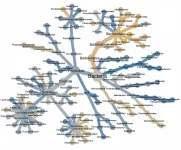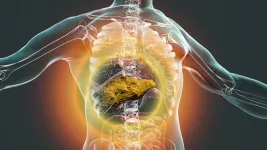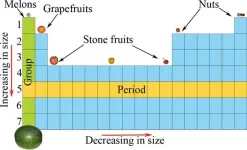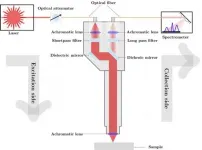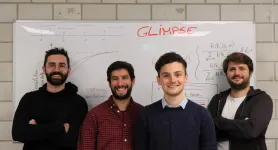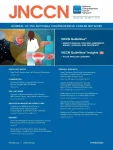Spilling the beans on coffee's true identity
2021-01-13
(Press-News.org) People worldwide want their coffee to be both satisfying and reasonably priced. To meet these standards, roasters typically use a blend of two types of beans, arabica and robusta. But, some use more of the cheaper robusta than they acknowledge, as the bean composition is difficult to determine after roasting. Now, researchers reporting in ACS' Journal of Agricultural and Food Chemistry have developed a new way to assess exactly what's in that cup of joe.
Coffee blends can have good quality and flavor. However, arabica beans are more desirable than other types, resulting in a higher market value for blends containing a higher proportion of this variety. In some cases, producers dilute their blends with the less expensive robusta beans, yet that is hard for consumers to discern. Recently, methods involving chromatography or spectroscopy were developed for coffee authentication, but most of these are labor- and time-intensive, or use chloroform for the extraction, which limits the types of compounds that can be detected. In some studies, researchers used nuclear magnetic resonance (NMR) spectroscopy to monitor the amount of 16-O-methylcafestol (16-OMC) in coffee, but its concentrations vary depending on geographic location and cultivar. So, Fabrice Berrué and colleagues wanted to build on their previous work with NMR to assess the chemical make-up of each coffee bean variety and confirm the blends of real samples.
The researchers extracted compounds from a test set of pure coffee and known blends with methanol and identified the compounds with NMR. The team found 12 compounds with measurable concentrations, and two had significantly different amounts between the coffee varieties. Elevated concentrations of 16-OMC were unique to robusta, while high concentrations of kahewol -- a compound previously found in coffee beans by other researchers -- were distinct in arabica. There was a direct, reproducible relationship between 16-OMC and kahewol concentrations found in the blends of the two varieties. The team then measured 16-OMC and kahewol levels, in addition to other flavor molecules, in 292 samples from producers around the world. They could successfully authenticate pure coffee, even with relatively low concentrations of the two indicator compounds. For samples in which the composition of blends was known, the team's predictions were within 15% of the actual ratio. The new method results in a more robust and reliable way to verify unadulterated coffee and predict blends than previously reported approaches, the researchers say.
INFORMATION:
The authors do not acknowledge a funding source for this study.
The abstract that accompanies this paper is available here.
The American Chemical Society (ACS) is a nonprofit organization chartered by the U.S. Congress. ACS' mission is to advance the broader chemistry enterprise and its practitioners for the benefit of Earth and its people. The Society is a global leader in providing access to chemistry-related information and research through its multiple research solutions, peer-reviewed journals, scientific conferences, eBooks and weekly news periodical Chemical & Engineering News. ACS journals are among the most cited, most trusted and most read within the scientific literature; however, ACS itself does not conduct chemical research. As a specialist in scientific information solutions (including SciFinder® and STN®), its CAS division powers global research, discovery and innovation. ACS' main offices are in Washington, D.C., and Columbus, Ohio.
To automatically receive news releases from the American Chemical Society, contact newsroom@acs.org.
Follow us: Twitter | Facebook
ELSE PRESS RELEASES FROM THIS DATE:
2021-01-13
DURHAM, N.C. -- Biomedical engineers at Duke University have devised an algorithm to remove contaminated microbial genetic information from The Cancer Genome Atlas (TCGA). With a clearer picture of the microbiota living in various organs in both healthy and cancerous states, researchers will now be able to find new biomarkers of disease and better understand how numerous cancers affect the human body.
In the first study using the newly decontaminated dataset, the researchers have already discovered that normal and cancerous organ tissues have a slightly different microbiota composition, that bacteria from these diseased sites can enter the bloodstream, and that this bacterial information could help diagnose ...
2021-01-13
Liver transplant priority in the U.S. goes to the sickest patients, which fails to consider other important factors, including how long patients are likely to survive post-transplant.
Researchers with Sylvester Comprehensive Cancer Center at the University of Miami Miller School of Medicine are collaborating with faculty at the University of Pennsylvania to develop a risk score that more comprehensively prioritizes liver cancer patients for transplantation.
Their paper documenting the development and validation of the LiTES-HCC score to predict post-transplant survival for hepatocellular carcinoma, or liver cancer, patients was published in the highly respected peer-reviewed Journal of Hepatology.
The ...
2021-01-13
Egg cells are among the largest cells in the animal kingdom. If moved only by the random jostlings of water molecules, a protein could take hours or even days to drift from one side of a forming egg cell to the other. Luckily, nature has developed a faster way: cell-spanning whirlpools in the immature egg cells of animals such as mice, zebrafish and fruit flies. These vortices enable cross-cell commutes that take just a fraction of the time. But until now, scientists didn't know how these crucial flows formed.
Using mathematical modeling, researchers now have an answer. The gyres result from the collective behavior of rodlike molecular ...
2021-01-13
Many students, especially non-science majors, dread chemistry. The first lesson in an introductory chemistry course typically deals with how to interpret the periodic table of elements, but its complexity can be overwhelming to students with little or no previous exposure. Now, researchers reporting in ACS' Journal of Chemical Education introduce an innovative way to make learning about the elements much more approachable -- by using "pseudo" periodic tables filled with superheroes, foods and apps.
One of the fundamental topics taught in first-year undergraduate chemistry courses is ...
2021-01-13
WASHINGTON -- In a new study, researchers show that a light-based analytical technique known as Raman spectroscopy could aid in early detection of oral squamous cell carcinoma (OSCC).
OSCC is the most prevalent type of oral cancer and ranks among the most common cancers diagnosed worldwide. Although effective treatments are available, the cancer is often not detected until a late stage, resulting in overall poor prognosis.
"Raman spectroscopy is not only label-free and non-invasive, but it can potentially be used in ambient light conditions," says research team leader Levi Matthies from University Medical Center Hamburg-Eppendorf in Germany. "This makes it promising for use as a potential screening tool ...
2021-01-13
Cardiovascular Innovations and Applications, publishes selected abstracts from the 31st Great Wall International Cardiology (GW-ICC) Conference, October 19 - 25, 2020
Beijing, January 13, 2021: Cardiovascular Innovations and Applications (CVIA), in its role as the official journal of the Great Wall International Cardiology Conference (GW-ICC), has published selected abstracts from the 31st GW-ICC. Abstracts are now online at https://www.ingentaconnect.com/content/cscript/cvia/2020/00000005/a00101s1/art00001
Co-Editors-in-Chief of CVIA Dr. C. Richard Conti, past president of the American College of Cardiology, and Dr Jianzeng Dong, Capital Medical University, Beijing, China commented that CVIA is delighted to be ...
2021-01-13
Thousands of genetic markers have already been robustly associated with complex human traits, such as Alzheimer's disease, cancer, obesity, or height. To discover these associations, researchers need to compare the genomes of many individuals at millions of genetic locations or markers, and therefore require cost-effective genotyping technologies. A new statistical method, developed by Olivier Delaneau's group at the SIB Swiss Institute of Bioinformatics and the University of Lausanne (UNIL), offers game-changing possibilities. For less than $1 in computational cost, GLIMPSE is able to statistically infer a complete human genome from a very small amount of data. The method offers ...
2021-01-13
Researchers at Brazil's National Space Research Institute (INPE), in partnership with colleagues in the United States, United Kingdom and South Africa, have recorded for the first time the formation and branching of luminous structures by lightning strikes.
Analyzing images captured by a super slow motion camera, they discovered why lightning strikes bifurcate and sometimes then form luminous structures interpreted by the human eye as flickers.
The study was supported by São Paulo Research Foundation - FAPESP. An article outlining its results is published in Scientific Reports.
"We managed to obtain the first optical observation of these phenomena and find a possible explanation for branching and flickering," Marcelo Magalhães Fares Saba, ...
2021-01-13
Spatial isolation is known to promote speciation - but researchers at Ludwig-Maximilians-Universitaet (LMU) in Munich have now shown that, at least in yeast, the opposite is also true. New ecological variants can also evolve within thoroughly mixed populations.
The idea that speciation is based on the selection of variants that are better adapted to the local environmental conditions is at the heart of Charles Darwin's theory of the origin of species - and it is now known to be a central component of biological evolution, and thus of biodiversity. Geographic isolation of populations is often regarded as a necessary condition for ecotypes to diverge ...
2021-01-13
PLYMOUTH MEETING, PA [January 13, 2021] -- New research in the January 2021 issue of JNCCN--Journal of the National Comprehensive Cancer Network finds more than a third of eligible people miss timely screening tests for colorectal cancer and at least a quarter appear to miss timely screening tests for breast and cervical cancers. The study comes from the University of Alberta, Faculty of Medicine and Dentistry in Alberta, Canada, with findings based on self-reported results from the Canadian Community Health Survey (CCHS) from 2007-2016. According to the author, the results also ...
LAST 30 PRESS RELEASES:
[Press-News.org] Spilling the beans on coffee's true identity
